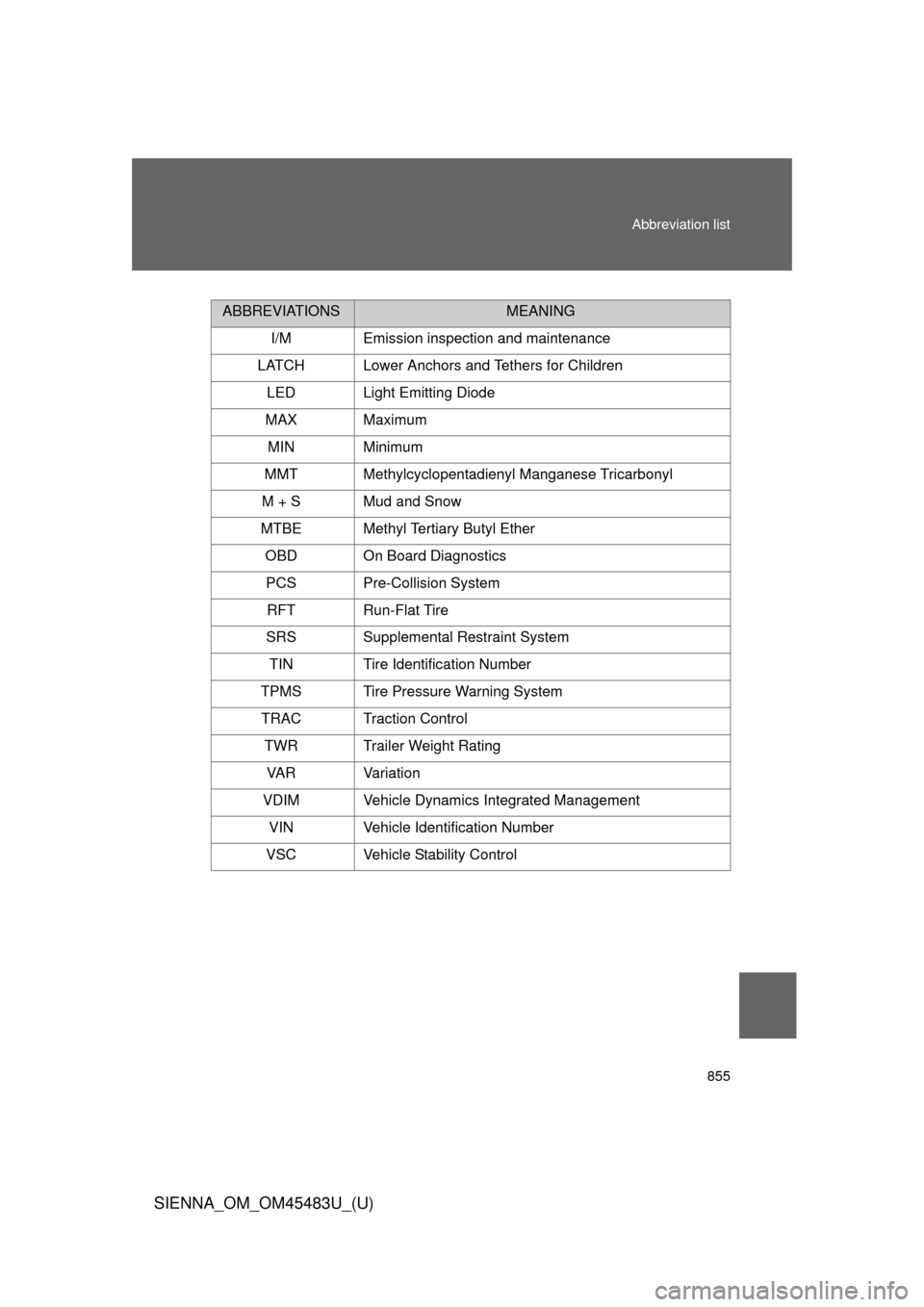TPMS TOYOTA SIENNA 2014 XL30 / 3.G Owners Manual
[x] Cancel search | Manufacturer: TOYOTA, Model Year: 2014, Model line: SIENNA, Model: TOYOTA SIENNA 2014 XL30 / 3.GPages: 872, PDF Size: 15.99 MB
Page 720 of 872

720 4-3. Do-it-yourself maintenance
SIENNA_OM_OM45483U_(U)
FuseAmpereCircuit
6 ECU-IG NO.1 10 A Multiplex communication system,
stop lights, navigation system,
vehicle stability control system,
Active Torque Control 4WD, intui-
tive parking assist, auto anti-glare
inside rear view mirror, pre-collision
seat belt, outside rear view mirror,
seat heater, TPMS, yaw rate & G
sensor, steering angle sensor,
AUTO ACCESS SEAT, main body
ECU, Blind Spot Monitor
7 P/W RL 20 A Rear power windows (left-side)
8 D/L 15 A Power door lock system
9 P/SEAT FR 30 A Power front seat (right-side)
10 S/ROOF 30 A Moon roof 11 P/W RR 20 A Rear power windows (right-side)
12 P/W FR 20 A Front power windows (right-side)
13 P/SEAT FL 30 A Power front seat (left-side), driving
position memory system
14 STOP 10 A Stop lights, ABS, vehicle stability
control system, rear combination
light, high mounted stop light, auto-
matic transaxle, shift lock system,
multiplex communication system,
power third seat switch, multiport
fuel injection system/sequential
multiport fuel injection system,
trailer lights (stop lights)
15 P/W FL 20 A Front power windows (left-side)
Page 756 of 872

756 5-2. Steps to take in an emergency
SIENNA_OM_OM45483U_(U)
CAUTION
■If a blowout or sudden air leakage should occur
The tire pressure warning system may not activate immediately.
■Maintenance of the tires
Each tire, including the spare (if provided), should be checked monthly
when cold and inflated to the inflation pressure recommended by the
vehicle manufacturer on the vehicle placard or tire inflation pressure
label (tire and load information label). (If your vehicle has tires of a differ-
ent size than the size indicated on the vehicle placard or tire inflation
pressure label [tire and load information label], you should determine the
proper tire inflation pr essure for those tires.)
As an added safety feature, your vehicle has been equipped with a tire
pressure monitoring system (TPMS-ti re pressure warning system) that
illuminates a low tire pressure telltal e (tire pressure warning light) when
one or more of your tires is significantly under-inflated. Accordingly,
when the low tire pressu re telltale (tire pressure warning light) illumi-
nates, you should stop and check your tires as soon as possible, and
inflate them to the proper pressure. Driving on a significantly under-
inflated tire causes the tire to overheat and can lead to tire failure.
Under-inflation also reduces fuel effi ciency and tire tread life, and may
affect the vehicle’s handling and stopping ability.
Please note that the TPMS (tire pressure warning system) is not a sub-
stitute for proper tire main tenance, and it is the driver’s responsibility to
maintain correct tire pressure, even if under-inflation has not reached the
level to trigger illu mination of the TPMS low tire pressure telltale (tire
pressure warning light).
Page 757 of 872

5
When trouble arises
757
5-2. Steps to take in an emergency
SIENNA_OM_OM45483U_(U)
CAUTION
Your vehicle has also been equipped with a TPMS (tire pressure warning
system) malfunction indicator to indi
cate when the system is not operat-
ing properly. The TPMS (tire pressure warning system) malfunction indi-
cator is combined with the low tire pressure telltale (tire pressure
warning light). When the system det ects a malfunction, the telltale will
flash for approximately one minute an d then remain continuously illumi-
nated. This sequence will continue upon subsequent vehicle start-ups as
long as the malfunction exists. When the malfunction indi cator is illumi-
nated, the system may not be able to detect or signal low tire pressure
as intended.
TPMS (tire pressure warning system) malfunctions may occur for a vari-
ety of reasons, including the installati on of replacement or alternate tires
or wheels on the vehicle that prevent the TPMS (tire pressure warning
system) from functioning properly. Always check the TPMS (tire pres-
sure warning system) malfunction te lltale after replacing one or more
tires or wheels on your vehicle to ensure that the replacement or alter-
nate tires and wheels allow the TPMS (tire pressure warning system) to
continue to function properly.
NOTICE
■Precaution when installing a different tire
When a tire of a different specification or maker is installed, the tire pres-
sure warning system may not operate properly.
Page 855 of 872

855
Abbreviation list
SIENNA_OM_OM45483U_(U)
ABBREVIATIONSMEANING
I/M Emission inspection and maintenance
LATCH Lower Anchors and Tethers for Children
LED Light Emitting Diode
MAX Maximum MIN Minimum
MMT Methylcyclopentadienyl Manganese Tricarbonyl
M + S Mud and Snow
MTBE Methyl Tertiary Butyl Ether OBD On Board Diagnostics
PCS Pre-Collision System RFT Run-Flat Tire
SRS Supplemental Restraint System
TIN Tire Identification Number
TPMS Tire Pressure Warning System TRAC Traction Control
TWR Trailer Weight RatingVAR Variation
VDIM Vehicle Dynamics Integrated Management
VIN Vehicle Identification Number
VSC Vehicle Stability Control